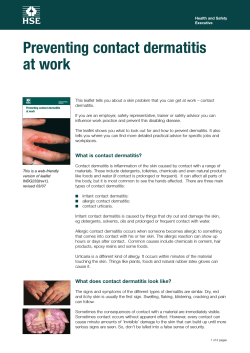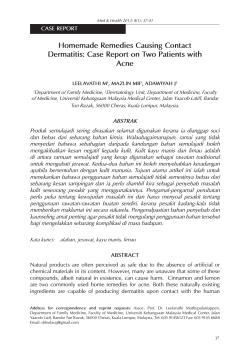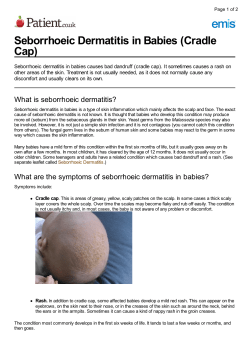
Canine Perioral Dermatitis Profile Definition Consultant on Call
Consultant on Call Dermatology Peer Reviewed Canine Perioral Dermatitis Jennifer Schissler Pendergraft, DVM, MS, DACVD Colorado State University Profile Definition ■ Perioral dermatitis (PD) is inflammation of the maxillary or mandibular cutaneous or mucocutaneous tissues. ■ PD has diverse clinical presentations and causes and may be noted as a singular clinical entity or among generalized dermatologic or systemic signs. Systems ■ PD is not limited to lip fold intertrigo (ie, bacterial and Malassezia spp overgrowth; Figure 1); rather, it is a potential manifestation of focal or generalized cutaneous conditions. ❏ Conditions include hypersensitivities, immune-mediated dermatopathy, infection, hepatopathy, periodontal disease, and neoplasia. 1 Lip fold intertrigo in a dog signalment & Causes ■ See Causes of Perioral Dermatitis, page 59, for causes and presentations. ❏ Some causes have known breed and age associations. Risk Factors ■ Redundant lip folds can predispose patients to intertrigo. ❏ Any primary cause of PD poses risk for secondary bacterial or Malassezia spp infection. ■ Chronic use of topical or systemic glucocorticoids poses risk for demodicosis. ■ Sun exposure can pose a risk for pemphigus foliaceus and discoid lupus erythematosus (Figure 2). Pathophysiology ■ Cutaneous or mucocutaneous inflammation can occur from causes that prompt erythema, pruritus, and primary lesions (eg, papules, pustules, vesicles, bullae), followed by secondary lesions (eg, erosions, ulcerations, crusts, alopecia). ❏ The resulting skin barrier disruption predisposes patients to secondary bacterial and Malassezia spp overgrowth. 2 Discoid lupus erythematosus in a dog 3 Zinc-responsive dermatitis in a dog MORE PD = perioral dermatitis August 2013 • clinician’s brief 55 Consultant on Call ■ The microenvironment of a deep, redundant lip fold predisposes patients to intertrigo. ■ Severe periodontal disease with ptyalism may predispose to secondary perioral infection, particularly with deep lip folds. ■ Pruritus and malodor are common. History ■ Signalment and clinical signs should be noted and history recorded: ❏ Degree, location, and seasonality of pruritus ❏ Duration and progression of lesions ❏ Previous treatments and response ❏ Dietary history Physical Examination ■ Cutaneous examination (eg, of the footpads, interdigital spaces, and nasal planum) should be completed. ■ Otoscopic and ophthalmic examinations should be performed. ■ The oral cavity, mucous membranes, and mucocutaneous junctions should be examined. ■ Lymphadenopathy should be assessed and lymph nodes palpated. ■ Patients with nonseasonal perioral pruritus may require an 8-week prescription or home-cooked elimination diet to differentiate atopic dermatitis (Figure 5) from cutaneous adverse food reaction (CAFR). Cytology ■ Acetate tape preparation (only for dry lesions) and impression smear of exudates should be performed to assess for bacteria, Malassezia spp, and presence of acantholytic keratinocytes. Fine-needle Aspiration ■ Nodules and enlarged lymph nodes should be aspirated. Deep skin scrape ■ Deep skin scrape or pluck for Demodex spp (Figure 6) should be performed in all cases. ❏ If patient compliance impedes the performance of a deep skin scrape, several representative areas (~100 hairs per sample) can be plucked and examined with mineral oil and a coverslip.1 Cultures ■ Dermatophyte culture is indicated if lesions are consistent (see Causes of Perioral Dermatitis, page 59) and secondary infection and Demodex spp have been ruled out. ■ Bacterial culture is indicated if clinical and cytologic response to antimicrobial therapy is lacking. ■ Culture nodular or ulcerative lesions if bacteria are found on cytology; culture superficial lesions if intracellular rods are found. Elimination Diet Trial ■ A strict novel or hydrolyzed diet or home-cooked novel diet should be prescribed for a minimum of 8 weeks to differentiate CAFR from nonseasonal atopic dermatitis. ❏ Diet should be rechallenged to confirm the diagnosis. 4 Diagnosis Definitive Diagnosis ■ Definitive diagnosis is achieved via history, examination, and appropriate diagnostics (see Perioral Dermatitis in Dogs, a Management Tree, page 62). ■ Secondary infections should be resolved, as they can confound clinical and histopathologic features of the primary cause. ■ Histopathology is required for diagnosis of immune-mediated disease, superficial necrolytic dermatitis, zinc-responsive dermatitis (Figure 3, previous page), and cutaneous epitheliotropic lymphoma (Figure 4). B A C 56 cliniciansbrief.com • August 2013 Cutaneous epitheliotropic lymphoma in various canine patients 5 6 Atopic lip fold dermatitis with cheilitis and secondary Staphylococcus spp infection Histopathology ■ Vesiculobullous presentations (Figure 7) and lesions that remain after resolution of secondary infection should undergo biopsy. ❏ Multiple lesions representing all stages of disease should be sampled. Additional Diagnostics ■ Serum biochemistry profile and abdominal ultrasonography are recommended to support diagnosis of superficial necrolytic dermatitis. ■ CBC, serum biochemistry profile, fecal flotation, and urinalysis are recommended in cases of adult-onset generalized demodicosis to screen for underlying systemic disease. Treatment Lip Fold Intertrigo ■ Daily use of topical antiseptic and drying agents should be initiated. ❏ 2% acetic acid, 2% boric acid, and antimicrobial-based wipes and solutions are appropriate for maintenance therapy. ■ Acid- and alcohol-based topical medications are not recommended for erosive or ulcerative lesions. ❏ If erosions, ulcers, crusts, nodules, or depigmentation are present, systemic antimicrobial therapy is indicated (see Bacterial Infection & Mucocutaneous Pyoderma). ■ Cheiloplasty is curative in patients CAFR = cutaneous adverse food reaction Perioral and facial demodicosis in a dog that have lip fold intertrigo (with no other underlying cause) and are refractory to maintenance therapy. Bacterial Infection & Mucocutaneous Pyoderma ■ Topical therapy is recommended in all cases. ■ Systemic antimicrobial therapy is recommended for erosive or ulcerative, crusting, and depigmentation presentations. ■ If cocci are found on cytology, appropriate empirical choices include: ❏ Clindamycin at 11 mg/kg PO q12–24h ❏ Cephalexin at 22–30 mg/kg PO q12h ❏ Cefpodoxime at 5–10 mg/kg PO q24h ❏ Cefovecin at 8 mg/kg SC q14d up to 2–3 times ❏ Amoxicillin–clavulanate at 13.75 mg/kg PO q12h ■ Solutions and wipes containing 2% acetic acid, 2% boric acid, or 2%–4% chlorhexidine may be used daily and maintained q3–7d after resolution. ■ Avoid acid or alcohol-containing products if erosions are present. ■ Shampoos containing 2.5% benzoyl peroxide or 2%–4% chlorhexidine may be used 2–3 times weekly. ■ For mixed infections and ulcerative lesions, silver sulfadiazine cream should be considered. ■ Mupirocin ointment is most appropri- 7 Mucous membrane pemphigoid in a dog ate for methicillin-resistant Staphylococcus spp infections. Malassezia spp Infection ■ These infections should be treated topically. ■ Solutions and wipes containing 2% acetic acid, 2% boric acid, 2%–4% chlorhexidine, 2% miconazole, or 1%–2% ketoconazole may be used q24–48h until resolved, then maintained 1–2 times weekly. ■ Focal, dry presentations should be treated with daily applications of ointments with 1% clotrimazole, 1%– 2% miconazole, 1% terbinafine, 4% thiabendazole, or nystatin. ■ Shampoos with 1%–2% ketoconazole, 2% miconazole, 2%–4% chlorhexidine, or 2.5% benzoyl peroxide may be used 2–3 times weekly. ■ Adjunct systemic therapy for generalized or severe multifocal presentations should be initiated: ❏ Ketoconazole at 5–10 mg/kg PO q24h ❏ Itraconazole at 5–10 mg/kg PO q24h ❏ Fluconazole at 10 mg/kg PO q24h ❏ Terbinafine at 30 mg/kg PO q24h Dermatophytosis ■ These infections should be treated systemically and topically (see Malassezia spp Infection). ❏ Lime sulfur may be used for generalized presentations. MORE August 2013 • clinician’s brief 57 Consultant on Call Immune-Mediated Conditions* ■ Mild focal presentations may be managed with 0.1% topical tacrolimus (Protopic, protopic.com) and/or doxycycline and niacinamide. ■ Typically severe presentations initially require prednisolone at 2 mg/kg q24h. ❏ A secondary immunomodulator may be administered as a steroid-sparing agent or to achieve remission. ■ Immunomodulating agents include azathioprine, cyclosporine A, mycophenolate, and chlorambucil. ■ Diagnosis, condition severity, and potential adverse effects will influence treatment choices. ■ Juvenile cellulitis (Figure 8) is treated with prednisolone as sole therapy. ■ For mild cutaneous drug eruptions, discontinuation of the drug alone may be sufficient. Generalized Demodicosis ■ Treatment options include: ❏ Amitraz (Mitaban, zoetis.com) dips q14d ❏ Ivermectin (Ivomec, merial.com) at 0.3–0.6 mg/kg PO q24h ❏ Milbemycin oxime at 1–2 mg/kg PO q24h ❏ Doramectin (Dectomax, zoetis.com) at 0.6 mg/kg PO or SC q7d2 ❏ Topical 10% imidacloprid and 2.5% moxidectin (Advantage Multi for Dogs, bayerdvm.com) q7–14d3 (off label) Epitheliotropic Lymphoma* ■ Therapies include prednisolone as well as oral, injectable, and topical chemotherapeutic agents. ■ Consultation with a veterinary oncologist is recommended. superficial necrolytic Dermatitis ■ Treatment includes topical antimicrobial therapy and IV and/or oral amino acid supplementation (Aminosyn, hospira.com) to manage dermatologic lesions. ■ Hepatopathy is treated symptomatically, and surgery or octreotide may be considered for pancreatic glucagonoma.4 ■ Prognosis for survival is poor to grave. 8 Juvenile cellulitis in a dog Vitiligo ■ No treatment is required or reliably effective. Focal Demodicosis ■ Treatment is not recommended; lesions are expected to resolve within 4–8 weeks. Zinc-Responsive Dermatosis ■ Lifelong supplementation with zinc gluconate at 5 mg/kg PO q24h, zinc sulfate at 10–15 mg/kg PO q24h, or zinc methionine at 1.7 mg/kg PO q24h is required; additional topical or oral glucocorticoid therapy may be needed. Hypersensitivity ■ CAFR is controlled via restrictive diet. ■ Treatment options for atopic dermatitis include but are not limited to: ❏ Immunotherapy CAFR = cutaneous adverse food reaction *A complete discussion of therapy is beyond the scope of this text. 58 cliniciansbrief.com • August 2013 ❏ ❏ ❏ ❏ Cyclosporine A Antihistamines Fatty acids Adjunct topical antiinflammatory and/or antimicrobial therapy Follow-up ■ Requirements depend on cause. ■ For infections, recheck clinical and cytologic response in 2–3 weeks to ensure topical and/or oral therapy is effective. * In General Relative Cost ■ Cost can vary. ■ Lip fold intertrigo (diagnosis and treatment): $–$$ ■ Cheiloplasty for lip fold intertrigo: $$$$ ■ Zinc-responsive dermatosis (diagnosis and management): $$–$$$ ■ Generalized demodicosis management: $$–$$$$ ■ Immune-mediated disease (diagnosis and management): $$$–$$$$$ ■ Superficial necrolytic dermatitis (diagnosis and management): $$$$–$$$$$ ■ cb Cost Key $ = up to $100 $$ = $101–$250 $$$ = $251–$500 $$$$ = $501–$1000 $$$$$ = more than $1000 See Aids & Resources, back page, for references & suggested reading. Table Causes of Perioral Dermatitis Causes of perioral dermatitis include but are not limited to the diseases listed. Except for intertrigo, these diseases may manifest without perioral involvement. Clinical signs Alopecia Crusts Depigmentation Erosions, ulcers Erythema Plaques Scales Locations, other signs Any cutaneous Footpads Lymphadenopathy Mucous membrane Age Adult Erythema Alopecia Comedones Crusts Nodules (advanced) Papules Pustules Scales Ulcers (advanced) Any, often facial Any cutaneous Ear canal <1 year Any Crusts Erythema Papules Pustules Scales Any cutaneous Any Parson Russell terrier Yorkshire terrier Erythema* Pruritus* Scales Axillae Ear canals Facial, periocular Groin Interdigital Perianal Ventral neck Any Any Immune-mediated cutaneous drug eruption Any Any Any Immune-mediated discoid lupus erythematosus Crusts Depigmentation Erosion Erythema Scales Facial, pinnal Footpads (rare) Nasal planum* Periocular Adult Immune-mediated juvenile cellulitis Alopecia Crusts Nodules Plaques Pustules Lameness Muzzle Pain Periocular Pinnae Purulent otitis Pyrexia Submandibular lymphadenopathy* 1–3 months Disease Cutaneous epitheliotropic lymphoma Demodex spp infection Focal (<5 locations) Generalized (>5 locations/pedal/ regional) Dermatophytosis Hypersensitivity Atopic dermatitis and/or cutaneous adverse food reaction (CAFR) *Feature occurs in nearly all cases Breed predisposition Any Shar-pei Staffordshire bull terrier Dachshund Golden retriever Gordon setter MORE August 2013 • clinician’s brief 59 Consultant on Call Clinical signs Crusts Erythema Pustules Locations, other signs Facial, pinnal Footpads Generalized Nasal planum Age Adult Breed predisposition Akita Chow chow Cocker spaniel English bulldog Labrador retriever Immune-mediated uveodermatologic syndrome Crusts Depigmentation Erythema Footpad Nasal planum Periocular Uveitis* Adult Akita Malamute Samoyed Lip fold intertrigo Crusts Deep, redundant lip fold* Depigmentation Erosions, ulcers Moist erythema Purulent exudate Adult Basset hound Saint Bernard Spaniels Mucocutaneous pyoderma Cheilitis Crusts Depigmentation Erosions, ulcers Erythema Fissures Anus Nares Periocular Vulva/prepuce Any German shepherd dog Superficial necrolytic dermatitis Crusts Erosions, ulceration Erythema Hyperkeratosis Scales Footpad* Adult Hepatopathy or glucagonoma* Hocks Perianal Pinna Lateral elbow Ulcers Vesicles Mucocutaneous Oral cavity Crusts Pain Bullae Footpad Facial, pinnal Generalized Vitiligo Depigmentation Leukotrichia Zinc-responsive dermatosis Crusts Erythema Hyperkeratosis Scales Disease Immune-mediated pemphigus foliaceus or erythematosus Vesiculobullous dermatosis Bullous pemphigoid Epidermolysis bullosa acquisita Mucous membrane pemphigoid Pemphigus foliaceus Adult Any Any cutaneous Mucous membrane Adult Doberman pinscher Rottweiler Facial Footpads Nasal planum Periocular Any Alaskan husky Malamute Note: Other lesions may occur with secondary bacterial or Malassezia spp overgrowth. *Feature occurs in nearly all cases 60 cliniciansbrief.com • August 2013 Any
© Copyright 2025





















